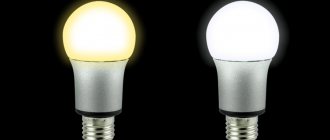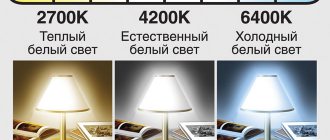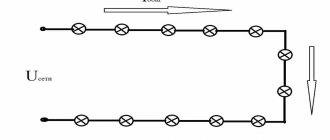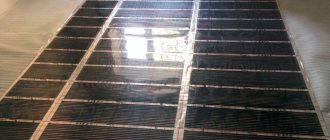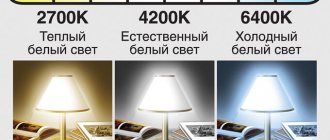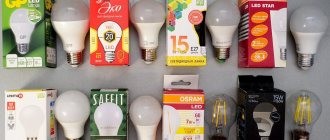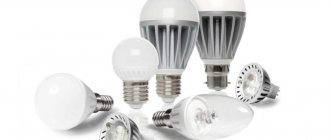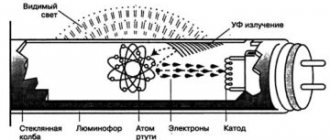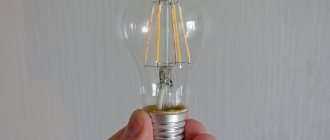The concept of color temperature plays an important role in interior design today. The visual perception of the situation, the feeling of comfort or discomfort, psychological mood, concentration, fatigue, and coziness depend on whether a particular room is illuminated with warm or cold light.
At the same time, for rooms with different functional purposes, the optimal color temperature is selected. How this is done correctly, and what you need to focus on when selecting light sources for a particular room, is described in easy-to-understand words in this article.
How lighting affects vision and mood
Cold light tones, warm light soothes.
As for the effect on the human central nervous system, different shades of lamps (cold, neutral, warm) work like this:
- Cold - invigorates, tones, increases concentration.
- Neutral - almost equal to daylight, therefore does not have a significant effect on the central nervous system.
- Warm - relaxes, creates a feeling of peace, comfort, softness.
Not a single shade of the lamp has a negative effect on the eyes. The exception is flickering light. It provokes increased tension in the visual organs when a person is at rest and when performing work that requires increased concentration: reading, watching TV, manicure, sewing, etc.
Additionally, shades of light can change the colors of surrounding objects - making them more muted or, on the contrary, brighter. Incandescent light can enhance all warm colors. Cold lighting also works in relation to related shades. Therefore, it is advisable to choose interior items and furniture for the house at the level of lighting that prevails in the desired room. Otherwise, unpleasant surprises are possible when arranging what you purchased.
With age, the lens of a person's eye turns slightly yellow. Therefore, all tones and lighting are seen in warmer variations. To correct this perception, you can add a cold lamp to the room.
What is color temperature
Any shade of light has its own color temperature. It is measured in kelvins (K). The scale from left to right starts at 800 K and ends at 20,000 K. The higher the Kelvin level, the cooler the lighting level. The indicator 800 K corresponds to the dim glow of a red-hot red body. The maximum parameter of 20,000 K is equal to the color of the sky at polar latitude.
To create artificial lighting, the consumer is mainly offered lamps with the following color temperature:
- 2700-3000 K. This is a standard incandescent lamp with a tungsten filament that provides warm light in the room.
- 4000-4100. This is neutral light, almost completely replicating daylight.
- 5000-6500 K. Cold shades of the lamp with an admixture of blue.
As a rule, on boxes with energy-saving light bulbs this parameter is marked in a visible place by the manufacturer.
Main conclusions
The color temperature parameter is the most important for LEDs and lamps based on them. The color of the source glow depends on it. Color temperature is measured in the range from 800 K (dark red glow) to 20000 K (bright blue sky at polar latitude), LED lamps are usually manufactured with a value of 2000-6500 K. Shades of glow can be divided into warm (yellow), neutral and cool ( blue) tones. Yellowish ones are used in residential areas (bedroom, nursery, living room). Neutral - in the kitchen, bathroom or office. Cold tones are not used at home. The psychological and emotional state of a person directly depends on this value. Yellow tones are calm and cozy. Blues, on the contrary, charge with energy.
What is better for a person: warm or cold light
The best option is a combination of all types of lighting in the room, which can be controlled as needed. For work that requires concentration, make the cold light lamp more intense; for relaxation in the evening, focus on warm shades of lighting.
Natural white light (neutral)
The most optimal option for illumination of working and living spaces. Such light bulbs do not distort the perception of interior items, do not change the color scheme and do not have a significant impact on a person’s mood. It is better to place such points of artificial light in the living room, children's room, hallway, bathroom, kitchen.
Neutral lighting around a woman’s dressing table is especially important.
Warm light
Warm lighting
This type of lighting is more often used in residential areas. In accordance with the original shade of the interior item, under warm lamps the following change occurs:
- Blue - loses intensity, becomes inexpressive, faded.
- Blue - produces greenish tints.
- Purple - transforms into deep shades of red.
- Dark blue (indigo) - changes to black.
In warm lighting, red, orange, brown, yellow, cream colors and other shades from this range look bright and catchy.
Since under the light of a warm lamp a spacious room visually loses its area, it is better to use such lighting only as local lighting. Or place several spotlights under the ceiling around the entire perimeter of the room.
Lamps with a temperature level of 2700-3000 K are ideally combined with all natural materials - wood, cotton, linen, brick, straw, vintage metal. It is good to combine such light with interior styles: modern, Provence, retro, eco, classic, ethnic style. You can connect it to vintage.
At home, the warm light of a light bulb is good to use in the nursery, fireplace room, living room, hallway, and in the bedroom in the form of lamps by the bed.
For public places, lighting in warm colors is good to use in the halls of themed bars, cafes, and restaurants. In boutiques, jewelry stores.
Street lighting with a warm lamp looks good on boulevards, parks, squares with long alleys.
Cold light
Cold lighting
This color temperature is recommended for use in office spaces, medical institutions, and laboratories.
Cold lighting visually enhances blue-blue shades, gray, white, steel colors. Warm tones when using such lamps, on the contrary, become muted, distorted, and dull.
Lamps with a cold temperature ideally fit into the interior of rooms with a predominance of geometric shapes, chrome or steel elements. The ideal combination of such lighting is noted with interiors of high-tech, modern, minimalism, futurism, Scandinavian and classical styles.
At home, it is better to use cold light as local light or only in the bathroom, in the kitchen work surface area.
For public places, energy-saving lamps with this color temperature are applicable in classrooms, offices, and warehouses. For street lighting, cold light lamps are installed on highways, stadiums, hangars, and production areas.
Features of color perception
The human eye is designed in such a way that it sensitively detects changes in color temperature in the range from 2500 to 10,000 K. At the same time, scientists have proven that the psychosomatic state largely depends on this lighting parameter.
The influence of color on emotions
The most pleasant temperature of light for the human eye belongs to the orange and yellow spectrum. This light is calming and relaxing. Lamps with this color temperature are recommended to be used in the morning and evening hours to make waking up pleasant and to fully relax after work.
Cool shades are good for work. It is no coincidence that lamps with cool white light are most often installed in offices: they help you concentrate and prevent you from being distracted from your work. However, at home, such light bulbs will be a disadvantage: they overload the nervous system and can provoke anxiety and insomnia.
Shades that gravitate towards the blue spectrum (color temperature more than 6000 K) provide maximum color discrimination and clarity of perception of objects, but staying in a room with such light for a long time is harmful to health. As a rule, such lamps are installed in museums, drawing workshops, jewelry stores, examination rooms in hospitals, etc.
Relationship between color temperature and lighting
If the light level is low, then warm tones, like a regular incandescent lamp, are best perceived. This type of lighting can be relaxing and calming. If you increase the level of illumination, the opposite effect will occur, the colors will begin to distort and it will be uncomfortable to be in the room. At the same time, if you screw one light bulb with a high color temperature into a large room, a feeling of anxiety will appear (remember how people perceive moonlight).
An approximate pattern looks like this:
- illumination less than 700 Lux - choose warm light (up to 2700-3400 K);
- illumination 700-2500 Lux - choose cold light (3000-5000 K).
Here's a chart that shows how the perception of color temperature changes depending on the light level:
Another interesting relationship between color temperature and illumination concerns visibility in a “noisy” optical environment.
Have you noticed that the fog lights have a yellow light? The fact is that its wavelength is several times longer than that of white light. Yellow light does not reflect from small objects (in particular, water spray), but bends around them
Due to this, when the fog lights are turned on, the driver sees the road further than if he had used high-beam headlights with white light.
How to choose a lamp for your home
To choose a light bulb for use in one of the rooms, you need to be guided by the following criteria in addition to color temperature:
- Operating principle. These include standard incandescent, LED, halogen, and fluorescent lamps. The latter are less suitable for use at home because they flicker strongly and have a very high color temperature. LED elements do not have a significant impact on the eyes or interior items, since they are local (point) lighting elements.
- Efficiency LEDs come first here. The last one has incandescent lamps.
- Color rendering index. Marked as Ra. An indicator from 83 to 100 is considered optimal. The higher it is, the less colors will be distorted when illuminated by such a lamp.
- Type of flask. It can have the shape of a spiral, pear, candle, tube, ball, etc. You can determine the required shape by the type of floor lamp/lampshade (open, closed).
- Price. Incandescent lamps are considered the cheapest. The most expensive are energy-saving ones. But the price of such elements is fully compensated by the low power consumption.
How much to spend on an element is determined by each master for himself.
Application
Light source color temperature:
- characterizes the spectral composition of the light source radiation,
- is the basis for the objectivity of the impression of the color of reflective objects and light sources.
For these reasons, it determines the color of objects perceived by the eye when observed in a given light (psychology of color perception).
Due to the fact that the color of an object depends both on its own spectral properties and on the nature of the lighting, natural and artificial lighting is regulated according to SP 52.13330.2011 (current edition of SNiP 23-05-95) primarily by color temperature.
Color temperature in photography, film and television
Color photographic film is produced for certain fixed color temperatures of the light source. Negative and slide films were produced balanced for shooting in daylight (5600 K) or in incandescent light (3200 K) - “evening” film. This made it possible to obtain a color-balanced image under standard lighting sources without the use of conversion filters or color correction. With the advent of masked negative color films, they began to be produced balanced at an intermediate color temperature - 4500 K - due to the inevitability of color correction in the process of printing a positive image. Thus, negative film became suitable for shooting in any light, providing an image that required little correction. When shooting with reversal film, the finished image cannot be corrected. Therefore, film for slides and TV news was always balanced for real light sources. When professionally shooting slides for printing, special devices were used to measure the color temperature of lighting (color meters) and conversion filters. In professional filming, the same technologies were used even when shooting on negative film.
Digital cameras and video cameras use automatic detection of color temperature or its preset depending on the shooting scene. In digital photography and television, this setting is called “white balance.” In some cases, the color temperature can be redefined during further processing of a digital photo or video, but in most cases this leads to a loss of color quality. Changing the white balance without loss of quality is possible when recording uncompressed photo and video images - Raw. The latter is widely used in digital cinema.
Light sources in printing
To obtain the most accurate color image at all stages of production, it is often recommended to maintain a standard color temperature of lighting of 6500 K (source D65): from order acceptance through evaluation of originals, scanning, retouching, screen proofing, digital proofing, color separation, analog proofing, printing proofs to printing of circulation and final delivery of printed products.
The D65 source with a color temperature of 6500 K has in its spectrum an ultraviolet component defined by the standard. Although the human eye does not perceive ultraviolet rays, many objects (including dyes) are capable of glowing under their influence. For example, without a UV component, paper will not be as white (optical brighteners are introduced into it), and advertising will not be as bright (luminescent dyes are often used in it). Thanks to optical brighteners, the whiteness of modern paper can exceed 100%.
Lamps with different color temperatures in the same room
Comparative characteristics of lamps
The main prohibition on using cold and warm lamps is screwing them into one chandelier. Otherwise, you can combine different color temperatures, but follow these recommendations:
- In living rooms, the top (main) type should always be warm or neutral white light.
- If you want to combine different levels of lighting, warmer sources are made below the ceiling level in the form of spotlights, sconces, and floor lamps. They can be turned on in the evening during family holidays and dim other lighting levels.
- It is allowed to install different lamps in the same room if the first ones work as the main source of light, and the second ones as an accent light source. An example is local spotlights over paintings, panels, and figurines.
- Different color temperatures are combined so that the rays of the lamps used never intersect.
- A combination of cold and neutral white light looks good.
It is undesirable to simultaneously turn on both types of different lighting, which can differ greatly from each other.
What light do you need for reading?
For long reading, doctors recommend combining the main and local types of lighting in the room. At the same time, their color temperatures should not have sharp changes. This has a beneficial effect on the eyes. If you use only local light (a table lamp), it is difficult to achieve the desired level of uniformity in illumination of a book. The organs of vision suffer from this.
The lamp must be placed above the book so that it does not produce glare or shadows. The light intensity level should be medium. Very bright or weak colors strain the eyes.
It doesn’t matter whether the light is warm or cold. The main thing is that both sources (main and local) do not differ (they are either cold or warm).
Performance characteristics
Traditionally, cool light is considered brighter. It is rather blinding, under it all the colors look faded and faded. However, you simply cannot do without it when performing precise manipulations: cleaning, cutting, drawing, printing, etc. Consequently, lamps with saturated cold flows will be simply ideal for installation in an office, work area in the kitchen, bathroom or hallway. With some restrictions, such lamps should be used in the work rooms of artists, fashion designers, and designers. This is because when painting a picture, creating a project or selecting materials, difficulties may arise with adequate color rendering. Since the eyes in such a spectrum incorrectly perceive the color palette - it seems less saturated
Therefore, if you often work at home, and due to your duty, precise adherence to the desired shades is extremely important - we recommend using neutral white light, or warmer yellow light
The golden mean between two extremes is neutral lighting, as close as possible to daylight. In principle, it can be used in any type of room, supplemented as needed with cold or warm elements. Often these lamps are used for basic (background) lighting.
Warm light promotes greater relaxation of the visual muscles, it does not dazzle the eye and does not cause fatigue. Therefore, it is this light background that is preferable to choose for the bedroom, nursery and kitchen. The spectrum emitted in this case is similar to sunlight, which means it does not cause discomfort to the visual apparatus, even if it remains under it for a long time. In addition, it practically does not distort the usual (in the daytime) appearance of surrounding objects. Cold makes the colors less bright and rich. Therefore, it is better to place a warm lamp near the cosmetic table or near the mirror in the bathroom so as not to overdo it with makeup. If desired, complement it with a mini-mirror with bright, cold lighting to create delicate makeup strokes.
Color rendering index (CRI or Ra)
The color rendering index refers to the quantitative ability of a lamp to correctly display colors in the interior. In English it sounds like “color rendering index” or simply “CRI” (Ra). The latter type of marking is often affixed to the product box.
The Ra value is calculated on a scale from 1 to 100, where 1 is the worst color reproduction with distortion, and 100 is the most accurate. A value between 80 and 100 is comfortable for the human eye.
The following Ra indicators are typical for different types of lamps:
- incandescent - 80;
- cheap fluorescent - 60-70 Ra;
- models from well-known manufacturers - 70-90;
- LED sources - from 80 or more;
- halogen - close to 100 Ra.
When choosing a light bulb for your home, always pay attention to the Ra level. Fundamental differences in this indicator in two neighboring elements lead to the predominance of the worst of them.
